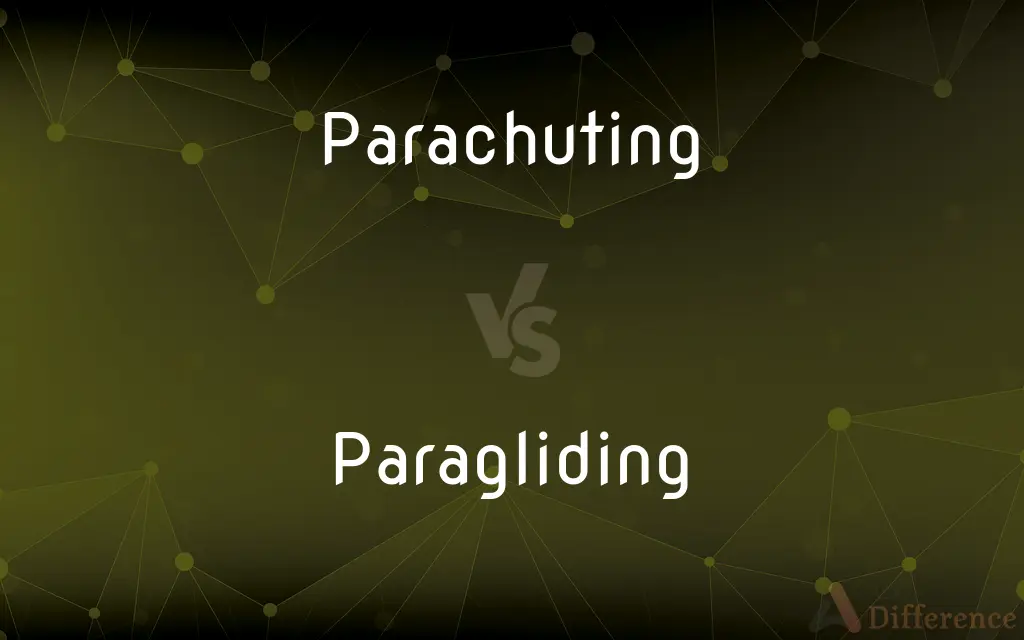Parachuting vs. Paragliding — What's the Difference?
By Fiza Rafique & Maham Liaqat — Updated on March 14, 2024
Parachuting involves jumping from an aircraft and descending with a parachute, focusing on freefall and controlled landing, while paragliding is launching from a hill or platform to glide through the air with a fabric wing, emphasizing sustained flight.

Difference Between Parachuting and Paragliding
Table of Contents
ADVERTISEMENT
Key Differences
Parachuting is an aerial activity where participants jump from an airplane or high place, experiencing freefall before deploying a parachute to slow their descent for a controlled landing. On the other hand, paragliding involves taking off from a hill or cliff with a paraglider, a type of foot-launched inflatable wing, to ride thermal currents for sustained flight, emphasizing the experience of prolonged airborne time and maneuverability in the air.
In parachuting, the thrill comes largely from the initial freefall, which can last from a few seconds to minutes, depending on the jump altitude, before the parachute is deployed. Whereas in paragliding, the thrill is derived from the ability to soar and glide across the sky for extended periods, using thermal updrafts to gain altitude and cover long distances.
Parachuting equipment includes a main parachute, a reserve chute, and sometimes an automatic activation device (AAD) for safety, which automatically deploys the parachute if the jumper cannot. In contrast, paragliding gear is simpler, mainly consisting of the wing itself, a harness, and a helmet, with the design focused on maximizing lift and flight duration.
The skills required for each sport also differ. Parachuting requires training in exit techniques, freefall body control, canopy control, and emergency procedures. Paragliding pilots need to understand meteorological conditions, thermal dynamics for lift, and precise control over the wing for takeoff, flight, and landing.
The environments where these activities are performed are distinct. Parachuting is typically done from airplanes over drop zones specifically designed for the sport, offering a variety of altitudes and challenges. Paragliding is often practiced from mountainous or hilly regions, taking advantage of natural landscapes to launch and find thermals for flight.
ADVERTISEMENT
Comparison Chart
Primary Thrill
Freefall and controlled landing
Sustained flight and maneuverability
Equipment
Parachute, reserve chute, AAD
Wing, harness, helmet
Skills Required
Exit, freefall, canopy control, emergencies
Understanding thermals, flight control
Environment
Airplanes, drop zones
Hills, mountains
Flight Duration
Short freefall, brief glide to landing
Extended, dependent on conditions
Compare with Definitions
Parachuting
Parachuting is the sport of jumping from an aircraft and descending with a parachute.
She went parachuting for the first time and loved the adrenaline rush of freefall.
Paragliding
Paragliding is flying with a fabric wing from a slope or cliff.
They took a paragliding course to learn how to soar above the mountains.
Parachuting
It involves both solo and tandem jumps.
Beginners often start with tandem parachuting, attached to an instructor.
Paragliding
The paraglider is controlled by shifting body weight and pulling on lines.
By pulling on the right line, she turned the paraglider towards the valley.
Parachuting
A parachute allows for a controlled descent to Earth.
The parachute opened smoothly, offering a stunning view during the descent.
Paragliding
It's a popular recreational and competitive sport.
He participates in paragliding competitions, testing his precision and distance.
Parachuting
Parachuting can include various disciplines, like skydiving and BASE jumping.
He specializes in BASE parachuting, jumping from fixed objects.
Paragliding
Safety gear includes a helmet and sometimes a reserve parachute.
Always check your safety gear before paragliding.
Parachuting
Training focuses on emergency procedures and safe landing.
Parachuting training ensures jumpers can handle any situation in the air.
Paragliding
Thermals are used to gain altitude during flights.
The pilot found a strong thermal to lift the paraglider higher.
Parachuting
Parachuting, including also skydiving, is a method of transiting from a high point in the atmosphere to the surface of Earth with the aid of gravity, involving the control of speed during the descent using a parachute or parachutes. For human skydiving, it may involve a phase of more or less free-falling (the skydiving segment) which is a period when the parachute has not yet been deployed and the body gradually accelerates to terminal velocity.
Paragliding
Paragliding is the recreational and competitive adventure sport of flying paragliders: lightweight, free-flying, foot-launched glider aircraft with no rigid primary structure. The pilot sits in a harness or lies supine in a cocoon-like 'speed bag' suspended below a fabric wing.
Parachuting
An apparatus used to retard free fall from an aircraft, consisting of a light, usually hemispherical canopy attached by cords to a harness and worn or stored folded until deployed in descent.
Paragliding
The sport or activity of flying by means of a paraglider.
Parachuting
Any of various similar unpowered devices that are used for retarding free-speeding or free-falling motion.
Paragliding
The sport of gliding with a paraglider.
Parachuting
To drop (supplies or troops, for example) by means of a parachute.
Paragliding
The use of a paraglider in other settings, such as surveillance or military applications.
Parachuting
To descend by means of a parachute.
Paragliding
Present participle of paraglide
Parachuting
The sport of jumping with a parachute.
Parachuting
Present participle of parachute
Parachuting
The act or process of descending from a high altitude to the ground by means of a parachute.
Parachuting
Descent with a parachute;
He had done a lot of parachuting in the army
Common Curiosities
Is parachuting or paragliding safer?
Both sports have inherent risks, but safety depends on proper training, adherence to safety protocols, and conditions during the activity.
Can you switch from parachuting to paragliding?
Yes, individuals can switch between the two, but each requires specific training and skills due to their different focuses and equipment.
What is the main difference between parachuting and paragliding?
The main difference is that parachuting involves descending from an aircraft with a parachute, focusing on freefall and controlled landing, while paragliding is about launching from a height and gliding through the air with a wing, emphasizing sustained flight.
Can parachuting be done without an aircraft?
Traditional parachuting requires an aircraft, but BASE jumping is a form of parachuting from fixed objects like buildings, antennas, spans (bridges), and earth (cliffs).
What are thermals in paragliding?
Thermals are columns of rising air created by uneven heating of the Earth's surface, which paragliders use to gain altitude.
How do weather conditions affect parachuting and paragliding?
Both activities depend heavily on weather conditions; poor weather can increase risk and may lead to cancellations.
How do you control a paraglider?
A paraglider is controlled by shifting the pilot's weight and pulling on brake lines to steer and adjust altitude.
What's the highest altitude for parachuting?
High-altitude jumps can exceed 15,000 feet, but these require additional oxygen and specialized training.
Can paragliding be competitive?
Yes, there are competitive paragliding events focused on cross-country flying, precision landing, and other challenges.
How long can you stay airborne in paragliding?
Flight duration depends on skill, weather, and thermals, with flights ranging from a few minutes to several hours.
Is it possible to paraglide without hills or mountains?
Yes, tow launching can be used to start a flight from flat ground.
What's a tandem jump in parachuting?
A tandem jump involves a novice being attached to an instructor using a dual-harness system for the jump.
Which is more expensive, parachuting or paragliding?
Initial costs can be high for both, but paragliding may incur lower ongoing costs since it doesn't typically require aircraft lifts.
Do you need a license for parachuting or paragliding?
Regulations vary by country, but training and certification by recognized organizations are generally required for both.
Can you parachute or paraglide at any time of the year?
While dependent on location and weather, both activities can be enjoyed year-round in suitable conditions.
Share Your Discovery

Previous Comparison
Exotoxin vs. Endotoxin
Next Comparison
Freeware vs. SharewareAuthor Spotlight
Written by
Fiza RafiqueFiza Rafique is a skilled content writer at AskDifference.com, where she meticulously refines and enhances written pieces. Drawing from her vast editorial expertise, Fiza ensures clarity, accuracy, and precision in every article. Passionate about language, she continually seeks to elevate the quality of content for readers worldwide.
Co-written by
Maham Liaqat















































